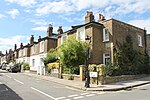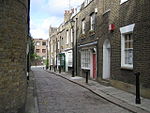Kentish Town rail accident
1861 in LondonAccidents and incidents involving London and North Western RailwayAccidents and incidents involving North London RailwayHistory of rail transport in LondonHistory of the London Borough of Camden ... and 7 more
Kentish TownRailway accidents and incidents in LondonRailway accidents caused by signaller's errorRailway accidents in 1861September 1861 eventsTrain collisions in EnglandUse British English from March 2018
On 2 September 1861, near Kentish Town station in London, 16 people were killed and 317 were injured when an excursion train operated by the North London Railway collided with a freight train operated by the London and North Western Railway.The excursion train was running early and had been given permission to proceed, but met the freight train as it crossed the lines at a freight sidings unprotected by signals.
Excerpt from the Wikipedia article Kentish Town rail accident (License: CC BY-SA 3.0, Authors).Kentish Town rail accident
Regis Road, London Kentish Town (London Borough of Camden)
Geographical coordinates (GPS) Address Nearby Places Show on map
Geographical coordinates (GPS)
| Latitude | Longitude |
|---|---|
| N 51.552222222222 ° | E -0.14694444444444 ° |
Address
SIG Roofing
Regis Road
NW5 1RU London, Kentish Town (London Borough of Camden)
England, United Kingdom
Open on Google Maps










